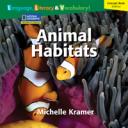Michelle Kramer’s Animal Habitats is an early reader concept book on animal habitats and features great photographs by National Geographic. The book walks through and explains what habitat is and what animals need to survive in their habitats. After explaining the importance of an animal’s habitat each the next several pages are dedicated to the different types of habitats. Each habitat has highlighted vocabulary for that specific habitat. The book also introduces several animals that small children may not have seen or heard of before; perhaps peaking the interest of those animal lovers. Each page about the separate habitat begins similarly and will help in the development of early reading skills. ” Sandy deserts are hot and dry places. Many animals live in this habitat. What helps them survive?” After the question is asked on each section about the habitat there are several boxes answering the questions. ” Fennec foxes dig holes underground to find shelter from the hot sun. The skink eats insects that lives in the desert. These camels are at an oasis. An oasis is a place in the desert that has water.” Even if the child is not reading on their own, the pictures are great and fill the pages.
Curriculum Connections
This book is a great resource when instructing students on Life Science and more specifically different habitats that animals live in. This book is filled with vocabulary and several animals associated with different habitats. National Geographic also features a page specifically for the teacher in the front cover of the book connecting the books major themes and key concepts that are learned. It also provides customized instruction for English Language Learner that will help a teacher meet their specific needs. (SOL 1.5 a, b, c)
Additional Resources
Frog Life Cycle is a page that shows an example of a simple craft to made showing the cycle of frogs. I think that students would enjoy making the project and still get an understand of the life cycle that frogs go through. The page also has free printable templates to complete the project. The directions are easy to follow and seem simple enough for the young students.
Animal Life Cycles is a page that has a detailed unit plan on animal life cycles. Not all of the activities would fit into the SOL curriculum but many of the ideas can be adapted and made to fit. This is also a great site because it give cross-curricular connections to art and language arts.
Studying the Life Cycle of Butterflies is a great lesson planning page from Scholastic. It provides background, vocabulary and activities for students that are associated with the life cycle of butterflies. The page also provides a list of supplemental reading for the children.
General Information
Book: Animal Habitats
Author: Michelle Kramer
Publisher:National Geographic School Publishing
Publication Date:2006
Pages:24
Grade Range: Pre-K to 2nd grade
ISBN:978-14263-50573

